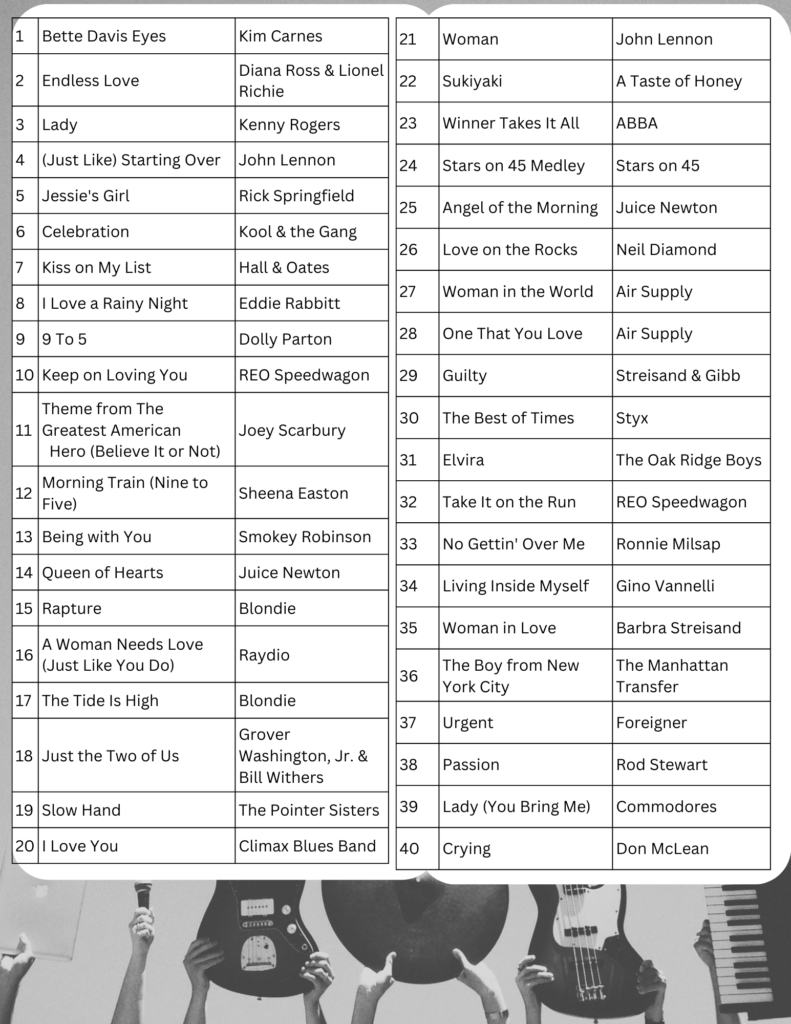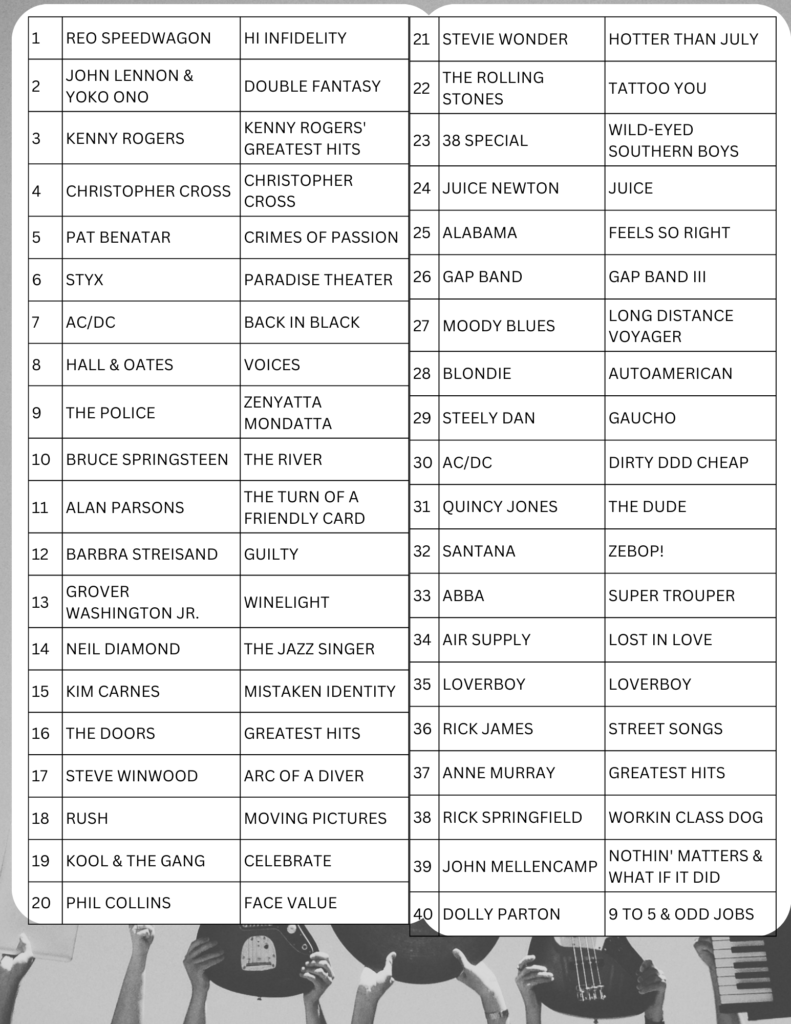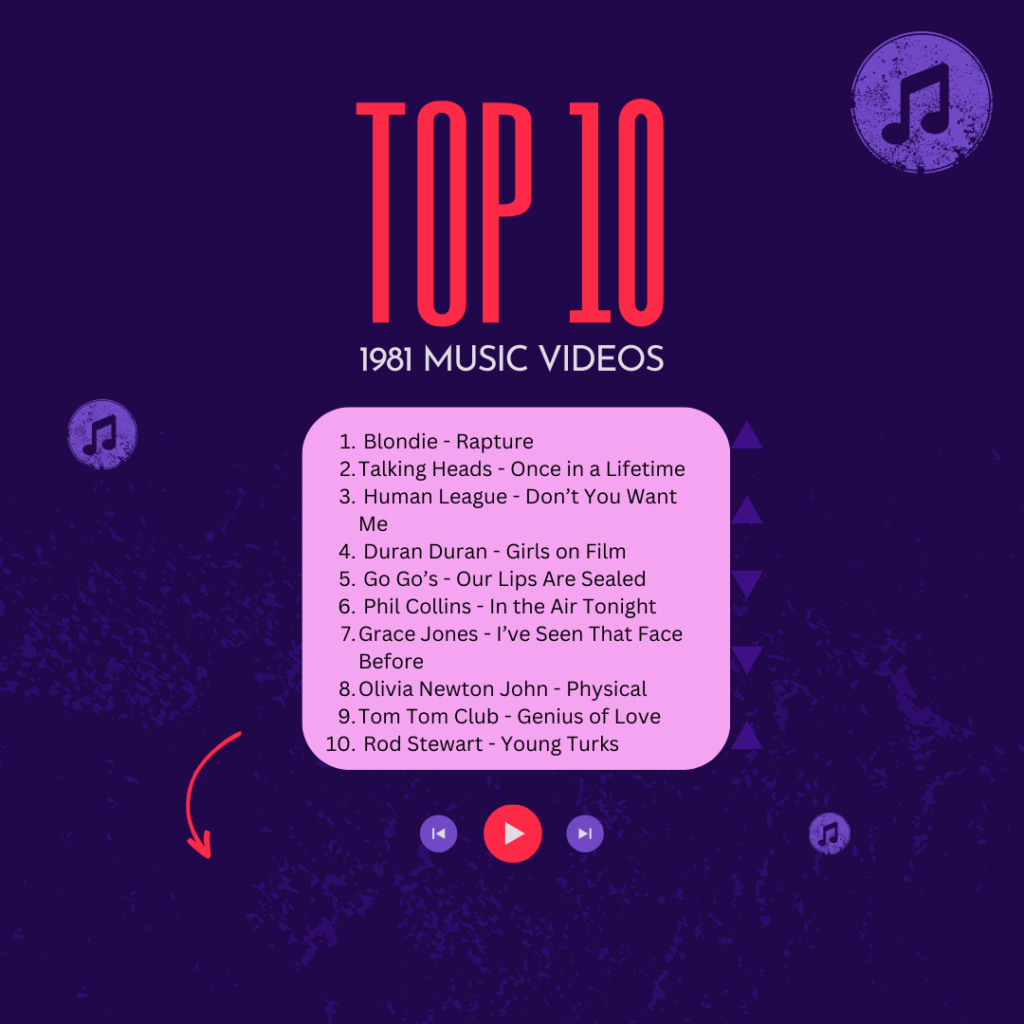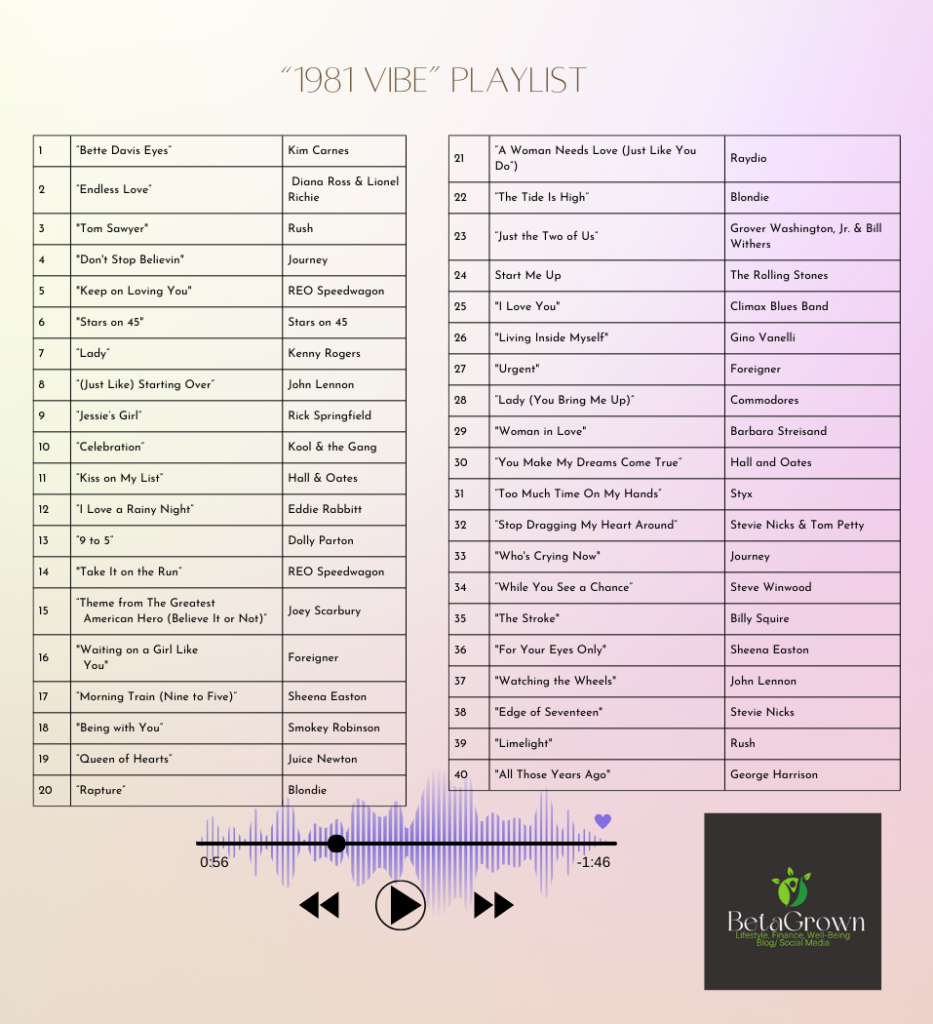1981 music gave us a watershed year for innovation and iconic albums. Also, given our target audience for BetaGrown is people who are 50 plus, we thought that 1981 would be a great year to provide our inaugural ‘Year in Sound’ post. For most of us, we are only beginning to leave the fire-shelter of our family home at seventeen, which makes it an important “breakaway” age. It gives more opportunity to control the films people like, the music they listen to, in this kind of independent atmosphere. Also, many of us probably feel that music is at its best when we are between the ages of 16 and 20. In the end, 1981 was quite a year musically and provides much food for thought so let’s begin to see and think again about those times.
Click Here for 1981 Music and Memorabilia Gift Options
Key Events in 1981
Did the events of1981 redirect history?! Just before we get into the musical aspect of 1981, we should first consider some of the significant events that colored our life and times as we cruised down the freeway with those cassettes cranked up (loudly).

Reagan Inaugurated
On January 20, Ronald Reagan was inaugurated as the 40th President of the United States. His presidency brought important changes in politics and foreign policy for the United States, termination of the Iran Hostage Crisis and in general helped most Americans to feel quite good about themselves. Mood Impact: Positive。
Iran Hostage Crisis Ended
The Iran Hostage Crisis began on November 4, 1979, when Iranian students stormed the US Embassy in Tehran and took 66 American citizens hostage. These prisoners were not released until a full 444 days later, when they walked free on January 20th, 1981. But during those months of terrible fear and uncertainty it had a major effect on how this country felt about itself, which also provided a great deal of relief and joy when it was over. Impact of Mood: Positive
1st Space Shuttle Launch is a Success
On April 14 the space shuttle Columbia finished up its first flight and landed back home safely. This was a major step in the history of space travel. It also provided encouragement to everyone who ever dreamed that one day they might travel in space or even explore other worlds themselves. Impact of Mood: Positive
1976 Music: The Peak Year for the Iconic Album Release – Learn why
Ali Hangs Up His Gloves
In 1981 legendary boxer Muhammad Ali watched his illustrious career come to an end. Although there were many appeals in different ways to get him to quit before his last fight, Ali went into ring one final time on December 11, 1981, at Nassau’s Queen Elizabeth Sports Centre. Trevor Berbick, his opponent, outlasted him for a ten-round decision and victory on points over Ali. This moving contest marked the end not only of an era for the charismatic fighter but for boxing itself. While people were sad they would no longer be able to see him in the ring, most realized that retirement was the right choice for the man. Impact of Mood: Neutral
AIDS Virus Discovered
The AIDS Virus was first identified in 1981. The impact of the epidemic has been great indeed since the first AIDS cases were reported in the United States in June 1981. Since that time, over 700,000 adults and children in the United States have died of AIDS. Although remarkable advances have been made in prevention, treatment, and awareness over the years these numbers remind us of the far-reaching implications of such a global health crisis. From a social standpoint, it gave a seventeen-year-old something to think about when free love, the prevailing idea of sex since 1960’s, turned sour. Mood impact: Very Negative
Presidential Assassination Attempt
On March 30, 1981, John Hinckley Jr. attempted to assassinate Ronald Reagan. While Reagan survived the assault, it had a large impact on the nation, influencing policies, security measures, and public perception of his presidency. President Reagan’s popularity increased after he survived the assassination attempt. Mood impact: Positive once he recovered.
Royal Wedding
In “The Wedding of the Century,” Prince Charles married Lady Diana Spencer at St. Paul’s Cathedral on Wednesday, July 29, 1981, in London before a media audience from all points of the compass. With an estimated audience of 750 million people around the globe watched on television, it was a cultural milestone, not to mention new records for ratings. Mood impact: Positive
Click here for a curated catalog of gifts for men
1981 Music by the Numbers
Before providing a narrative view of 1981 music, let’s look at which music was most popular from the perspective of Billboard which determined its rankings using factors such as radio airplay, sales, and overall popularity for the calendar year. This gives one a background on maybe some music one might well have heard when they turned on the radio in 1981.
Top 40 Songs of 1981 (Year-end edition Billboard Magazine)

Now let’s take a look at the album rankings. This provides an idea of artist popularity as well as how people felt about the individual songs that they released.
1981 Top 3 Albums From Amazon
Top 40 Selling Albums 1981 from Billboard Magazine

1981 Music World Happenings
The Birth of MTV

MTV — that’s Music Television — made its debut on August 1, 1981, and forever changed the music industry and pop culture. Though it wasn’t the first music-video-themed network (that honor goes to a pre-Saturday Night Live NBC show called “The Midnight Special” that experimented with videos from 1973 to 1981), it was the one that mattered, the first that truly flew as part of the cable industry’s new wave of themed networks (HBO, ESPN, CNN, etc.) that stirred in the late 1970s and exploded in the early 1980s, and the one whose significance and impact on the culture of its time were vast enough to render it a symbol and a living museum piece of the era, one whose very existence would come to define an entire generation of music lovers.
Related Post: Paul McCartney Top 50 Post Beatles Songs – Ranked!
The first video aired on the channel was The Buggles’ “Video Killed the Radio Star”, sending an appropriate message (if not a tremendously nuanced one) about the decline of traditional radio in the face of music experiences becoming increasingly visual. After initially hitting households in parts of New Jersey, MTV expanded to the rest of the United States, and then, the rest of the world. The early years consisted of videos delivered by record companies which VJs (video jockeys) then introduced. However, as record companies became wise to the promotional potential of an MTV add, they began to spend more money and time on the promotional videos, and Directors like Spike Jonze (Being John Malkovich, Her) and Michel Gondry (Eternal Sunshine of the Spotless Mind) cut their creative teeth on videos before moving on to feature films.
The channel’s importance in the music business was inestimable: During the early part of the decade, it was the medium that launched the careers of artists such as Madonna, Michael Jackson, Prince and Duran Duran. However, it quickly shifted to broader, higher-profile programming like reality shows, animated series, rock documentaries and public-service campaigns. It had few rivals in its cultural impact, from the controversial airing of Madonna’s “Like a Prayer” video to the creation of the MTV Music Video Awards, this channel left its mark as part of entertainment and music history.

More Notable Events in the Music World
New Order Emerges:
Following the tragic suicide of Ian Curtis, the remaining members of Joy Division reformed under the name New Order. They would contribute their official debut single, “Ceremony”, the first under the New Order moniker. The group would later become legends in the post-punk and electronic music genres.
Grammy Controversy:
The 23rd Annual Grammy Awards took place in New York. In a bit of a shocker, Christopher Cross walked away with a bit of hardware that night, and then some. The budding singer/songwriter won all four of the General Field awards at a single ceremony, including Album of the Year for his self-titled debut album. The move of course sparked much debate as it controversially beat out the heavily favored album, Pink Floyd’s The Wall.
Ultravox’s “Vienna”:
British synth-pop band Ultravox cranked all the way up to North American #2 on South African singles chart with their haunting track, “Vienna”. After racking up a massive number of UK sales and BBC radio plays with the track, the band would be stonewalled out of the top spot by Joe Dolce’s ‘Shaddup You Face’.
Eric Clapton’s Health Scare:
Guitar god Eric Clapton was rushed to a hospital in Saint Paul, Minnesota with bleeding ulcers. The event, which led to the indefinite postponement of Clapton’s current 60-city US Tour.
Simon & Garfunkel reunites – briefly and in a big way:
Simon & Garfunkel remained one of the best folk-rock bands ever and a notable duo with a troubled relationship, they had a series of number-one hits in the ’60s and ’70s. The pair went on hiatus after releasing their last studio album together in 1970, but they would continue to reunite whenever a particular song or a group of their fans called for it. One of the most important of these reunions happened in 1981. This one was simply called ‘The Concert in Central Park’. Over 500,000 fans showed up for the two-day performance, that is still one of the largest concert audiences in music history. With the success of the show, the duo was able to pick up thousands of new fans that were exposed to their music for the first time. “The Sound of Silence,” “Mrs. Robinson,” and “The Boxer” filled the air of the park and made the event one that no one present would ever forget.
Related Post: Fresh Tracks for Vintage Tastes. New and legacy artist’s updated takes on the classic rock genre.
Beatles News from 1981
By the time that 1981 rolled around, the band had been broken up for 11 years but the individuals who made up The Beatles remained key figures on the music scene throughout the 1970’s and into 1981. We thought it would be interesting to report on them from the perspective of this single year to highlight their lasting impact.
John Lennon:
Tragically, former Beatles member John Lennon was murdered outside his New York City apartment on December 8, 1980. His death was felt worldwide and left an unfillable hole in the music industry. His November 1980 release, Double Fantasy, was one of the top albums of 1981. Its three singles yielded two, year end Billboard Top 40 hits for the year. His legacy as a songwriter, musician, and advocate for peace endures to this day. His death marked the most difficult celebrity death that I have had to endure but I am grateful for the memories and the music that he left for all of us.
Paul McCartney:
Former Beatles bass player Paul McCartney spent 1981 busily expanding his solo career. Although his last album, “McCartney II”, was released in May 1980, he released no new material in 1981. McCartney spent most of the year in the studio, recording his next album, “Tug of War.” The album, released in 1982, would team him up with Beatles producer George Martin, as well as a host of great musicians. It would yield the hit duet with Stevie Wonder “Ebony and Ivory”, as well as “Take It Away.”
In 1981, McCartney was also working with Michael Jackson. They began recording two duets that would first appear on McCartney’s 1983 album “Pipes of Peace.” He was also working with his old friends and fellow Beatles. He, along with Starr and George Harrison, contributed to the chart-topping tribute to John Lennon, “All Those Years Ago”, which was released by George Harrison in 1981.
Paul McCartney: Top 50 Post Beatles Songs
Also in 1981, McCartney’s band Wings ended. McCartney formed Wings with his first wife Linda and Denny Laine. The band, a haven from the very public breakup of The Beatles, had been hinting the end was near since January 1980, but the official end came in 1981.
The year 1981 was unique in that it was the first year since 1962 that Paul McCartney did not release any new songs, neither as a member of a band nor as a solo artist.
George Harrison:
George Harrison released his ninth studio album, “Somewhere in England,” on June 1, 1981. The album was recorded as Harrison’s frustration with the music industry continued to grow. The album’s single, “All Those Years Ago,” was a tribute to his slain former bandmate, John Lennon, who had been murdered the previous year. Harrison had initially written the song for Ringo Starr, and after Lennon’s death he amended the lyrics to reflect that fact. The song featured contributions from Paul and Linda McCartney, as well as their Wings bandmate Denny Laine, and as such marked a very rare post-Beatles collaboration between all the surviving members. In 1981, Harrison also wrote and produced Ringo’s single, “Wrack My Brain,” which was featured on the “Stop and Smell the Roses” album of the same year
George also endured a court battle, as he was ordered on February 19 to pay ABKCO Music $587,000 for “subconscious plagiarism” of his song “My Sweet Lord” from Ronnie Mack’s song “He’s So Fine.”
Ringo Starr:
Ringo released “Stop and Smell the Roses” in 1981 and its title song as well as the George Harrison produced “Wrack My Brain” became minor radio favorites. As always, Ringo’s likable personality and drumming kept him in the public eye, with the film “Caveman” being released on April 17, 1981. The comedy film set in prehistoric times featured Starr in the lead role of Atouk, though critics panned it at the time. In the following years, “Caveman” has become a cult classic and is a favorite of Starr’s peace and love collaborator, filmmaker David Lynch.
After the Beatles disbanded, their individual frontiers continued to converge and their collective influence in popular music and culture continued undiminished in 1981.
1981 provided fertile ground for the growth of rap and hip-hop.
1981 was a pivotal year in the evolution of rap and hip-hop music, setting the stage for their eventual surge in popularity. Here’s how:
“Rapture” by Blondie:
“Rapture” by Blondie became a game-changer. Released in 1981, it was the first song featuring rap vocals to reach No. 1 on the Billboard Hot 100. Beyond its chart success, it had an even more significant impact: it was the first hip-hop music video ever played on MTV, airing twice on the network’s debut day, August 1, 1981. This crossover hit introduced rap to a broader audience, bridging the gap between rock and hip-hop.
Old School Roots:
The early days of hip-hop were rooted in the Bronx, NY, where local DJs, MCs (masters of ceremonies), break dancers, and graffiti writers created a vibrant street culture. DJ Kool Herc laid the blueprints with his b-beat, and performers took to local house parties, block parties, and community centers. By the mid-1970s, hip-hop had moved from neighborhood gatherings to local clubs, where it gained commercial recognition. Record producers and filmmakers noticed and capitalize on this emerging culture. Notable tracks like Grandmaster Flash and the Furious Five’s “Birthday Party” exemplified the party-oriented style of early rap music in 1981. Meanwhile, also in 1981, Dr. Dre was a DJ in Los Angeles and part of the electro group World Class Wreckin’ Cru. While Ice Cube was writing “Straight Outta Compton,” Dre was turning his talent and passion into a music career in the nascent hip-hop scene. That period gave Dre time to develop his style and technique that would influence the entire genre.
Technological Advances:
1981 marked a turning point for music production. Synthesizers, samplers, and drum machines became more accessible and affordable, in contrast to a few years prior when synthesis was still experimental. The iconic Roland TR-808 drum machine, born in 1981, revolutionized drum production for both R&B and hip-hop music. Instead of relying solely on DJ breakbeats, music producers could now program original drum patterns, freeing up a world of creativity and innovation for hip-hop production.
In summary, 1981 was a year that was instrumental in establishing the underpinnings of hip-hop by integrating rap into the mainstream, allowing these emerging artists to embrace new technology, and artistic expression through music as never seen before. One can see that this represents an incubation period that would eventually give birth to a dominant force in music very soon.
Album Highlights from ’81
1981 was a standout year in music, as evidenced by the wealth of classic albums and songs released across various genres. Here’s a look at the year’s high-octane highlights.
REO Speedwagon – “Hi Infidelity”: REO Speedwagon’s commercial breakthrough arrived with the release of this album on Nov. 21, 1980. It was a chart-topping smash hit in America, reaching No. 1 on the Billboard 200 and earning the honor of being the biggest-selling album of the year in 1981. It went on to receive a 10-times platinum certification from the RIAA, powered by the band’s first of two No. 1 hits: the lustrous power ballad “Keep on Loving You.” The song I have chosen to post in the above video, “Don’t Let Him Go” is not one of the hits, yet it might just be the best song on the album. With five tunes hitting Billboard’s chart, including “Take It on the Run”, “Hi Infidelity” is truly an ageless “for those about to rock” gem.
Journey – “Escape” (stylized as E5C4P3 on the album cover) is the seventh studio album by Journey. It was released on July 17, 1981, and for listeners, it was the perfect early-Eighties album to soundtrack that summer and beyond. The band’s first recording with keyboardist Jonathan Cain, the album co-produced by Kevin Elson and Mike Stone, with its quartet of hits – “Don’t Stop Believing,” “Who’s Crying Now,” “Still They Ride,” “Open Arms” – one of the iconic rock albums of its era remains the best of its breed: a complete album and songs that are still some of the most streamed even today.
Foreigner – “Foreigner 4,” also known simply as “4,” is the fourth studio album by Foreigner, which was released on July 3, 1981. It signaled a departure from hard rock to mainstream rock and pop music, with songs such as “Urgent,” “Waiting for a Girl Like You” and “Juke Box Hero.” The title of their album not only reflects its place in their discography, but it also marks their reduction from six to four members. The commercial success for “Foreigner 4″ was nothing short of phenomenal as it held the top spot on the Billboard album chart for ten weeks and its U.S. sales tally is now over six million.
ABBA – “The Visitors”: The Swedish pop quartet ABBA, known for their upbeat hits throughout the 1970s, took a dark, moody turn on their final album. With a more modern, synth-driven sound, “The Visitors” presaged the synth-pop craze that loomed on the horizon throughout the ’80s.
AC/DC – “For Those About to Rock (We Salute You)”: After the blockbuster success of “Back in Black,” AC/DC refashioned their raucous hard rock template once again to weave this classic platter that stormed to No. 1 on the U.S. album chart. Proving that “Back in” was no fluke, the album’s chart-topping status further cemented their iconic status in rock history.
The Cure – “Faith”: Although it didn’t set the bar in terms of the U.K. charts (where it topped out at No. 14), this eerie album of Gothic post-punk, led by Robert Smith’s chilling vocal, earned treasure over time. It would have a tremendous influence on “goth” music before impacting the alternative and post-punk genres much further.
Stevie Nicks – “Bella Donna” is an album by Stevie Nicks. Released on July 27, 1981, it was her first solo album and generated numerous hit singles. The album reached number one on the US Billboard 200 and, to date, has sold over four million copies in the United States, certifying it quadruple-platinum. Certainly, influenced with rock and country sounds, the album features several notable contributors such as Tom Petty, Waddy Wachtel, Roy Bittan, Donald “Duck” Dunn, Stan Lynch, Jim Keltner, and Don Henley. The singles from the album include: “Stop Dragging My Heart Around”, “Leather and Lace”, “Edge of Seventeen”, and “After the Glitter Fades”. “Bella Donna” was a huge album in 1981 by a monster talent who had already achieved success with Fleetwood Mac.
The Rolling Stones – “Tattoo You”: This 1981 Rolling Stones release gave the world songs like “Start Me Up” and “Waiting on a Friend.” For a compilation of leftover material from “Emotional Rescue” (the LP, obviously), and other sessions in the 70’s, it was a great follow-up and became one of their most successful albums.
The Human League – “Dare!”: The phrase “synth-pop classic” doesn’t do justice to The Human League’s “Dare!” — so let’s call it a synth-pop masterpiece. This release in 1981 featured songs like “Don’t You Want Me” and “Love Action (I Believe in Love).” This album, popularly known as the first album of the ’80s, produced what were essentially the five most important music videos ever to be aired back-to-back on MTV sort of.
Phil Collins’ Solo Debut: Not to be forgotten in 1981 is that Phil Collins released his first solo in 1981, “Face Value”, with the opening track “In the Air Tonight” which introduced the world to the gated reverb drum sound of the 80s. And yes, he was still in Genesis all the way through 1995.
Rush’s “Moving Pictures”: Rush put out their bestselling album “Moving Pictures” in 1981 and this masterpiece brought us “Tom Sawyer” and “Limelight.” This album probably introduced the band to the masses, which is important, but it really solidified some of the finest genius musicians of the 20th century as a total kick ass band. And I couldn’t be happier. Yes, I’m biased.
At the end of the day, these albums all ended up shaping not only what 1981 looked and sounded like, but how we consumed the music we loved, while redefining what music was capable of being.
1981 Albums on My Turntable
REO SPEEDWAGON HI INFIDELITY
JOHN LENNON & YOKO ONO DOUBLE FANTASY
CHRISTOPHER CROSS CHRISTOPHER CROSS
STYX PARADISE THEATER
AC/DC BACK IN BLACK
HALL & OATES VOICES
PHIL COLLINS FACE VALUE
THE ROLLING STONES TATTOO YOU
RUSH MOVING PICTURES
LOVERBOY LOVERBOY
JOURNEY ESCAPE
FOREIGNER 4
GENESIS ABACAB
THE WHO FACE DANCES
RUSH EXIT STAGE LEFT
TRIUMPH ALLIED FORCES
1981 Music and Memorabilia Options
1981 Playlist
Unlike 1981, when you would have to buy a lot of music or wait until the song came on the radio while you were ready to hit the record button and create your own mixtape, it is much easier to put together a digital playlist today. So we wanted to end this musical review of 1981 with a 40 song list that you could use to create a playlist in your favorite streaming or online service. This was designed so that it would bring the listener back to 1981 – and catch the vibe that this music created for millions. We hope you enjoyed our trip back in time!
Amazon Unlimited Music Subscribers: BetaGrown 1981 Vibe Playlist

